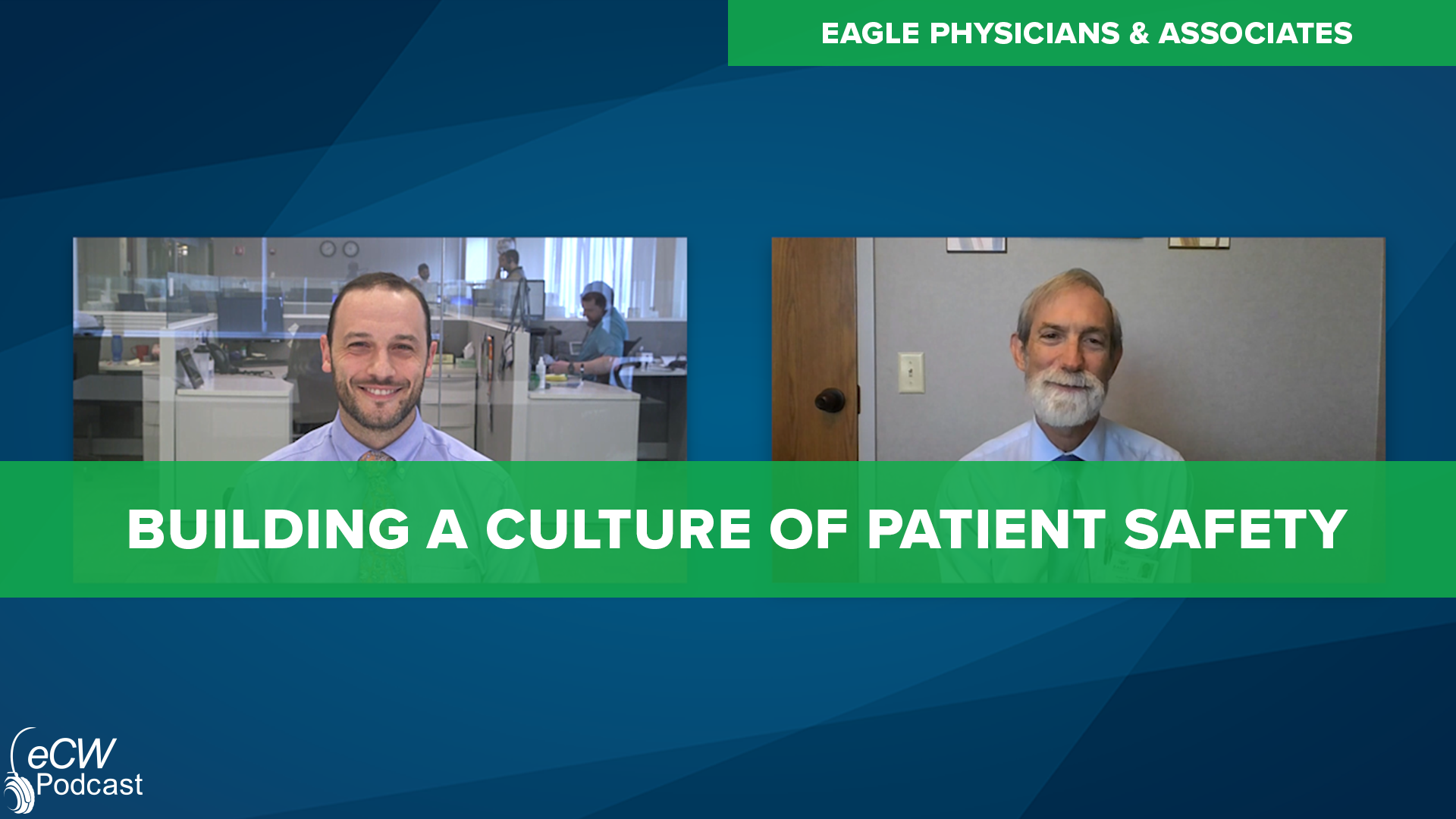
Published on Thursday, June 27, 2019
North Carolina’s Eagle Physicians and Associates has taken a leading role in developing a culture of patient safety, working both within the eClinicalWorks EHR and with an advisory group of physicians and pharmacists to develop and implement ever stronger guidelines for safe use of EHR technology.
“I’m going to applaud eClinicalWorks in getting CCM ready soon after the CCM program was initiated by CMS — and they developed and deliver when you turn on this program a bunch of care plans for a bunch of different problems, and they’re all problem-oriented.”
Dr. Robert Fried, Chief Medical Information Officer, Eagle Physicians and Associates

eCW Podcast
Transcript, Patient Safety with Eagle Physicians and Associates, Greensboro, NC
Adam Siladi: Welcome to this edition of the eClinicalWorks Podcast. As a company that supports clinicians in their mission to provide care, eClinicalWorks places a great deal of emphasis on patient safety. Now, eClinicalWorks continues to implement safeguards within the medical records itself, but also within its operations and processes, such as the adoption of standards like DB-0129 and the SAFER guidelines. But as much as eClinicalWorks has done and continues to do, patient safety is something that can only be achieved through collaboration. And here to speak with me today about patient safety and how they are collaborating with eClinicalWorks on that is Dr. Robert Fried, Chief Medical Information Officer at Eagle Physicians and Associates in Greensboro, North Carolina. Dr. Fried, thank you so much for taking your time to be with us today.
Dr. Robert Fried: Well, thank you so much for inviting me. I think this is an important topic to put out there and talk about over and over.
Siladi: I definitely agree. So, Dr. Fried, when I think about patient safety, I think about two things. There’s this idea of a culture of safety, and there’s also, you know, putting the rubber to the road as it were, and implementing those ideas of patient safety. I’d like to talk with you a little bit about culture first. So, what do you think are some of the elements of an effective culture of safety?
Dr. Fried: So, a culture of safety includes elements such as an emphasis, understanding that patient safety is, if you will, a prime directive of whatever organization we’re talking about. And then also, culture of safety should include a concept that just cultures put forth, which is that people can report errors, or report adverse events, report negative things, without any fear of a negative consequence on themselves. So, you need pre-reporting, you need as part of that, an understanding that when something bad happens, it’s not the individual’s fault, it’s the fault of the system, and therefore you look at the system and where the system is improved, and then the individuals aren’t so threatened.
Siladi: Now, Dr. Fried, I understand that you are also on the physician advisory board for eClinicalWorks. So, what does this group do and what does that have to do with patient safety?
Dr. Fried: Well, in the big picture, there’s responsibility of the EMR vendor to make their product work toward patient safety, and there’s also the responsibility of the users to use the program in a way that promotes patient safety. So, what this advisory group is, a group of about a dozen physicians and pharmacists who are users of eCW, who get together remotely on a monthly basis with Dr. Raj and the team of eClinicalWorks people who are oriented toward patient safety, and it’s a two-way street. So, we get to give input as to here’s where the product works against patient safety or doesn’t promote it in the way we want, and also we get presentations of ‘Here are the developments that we’re doing that we think will improve the usability of the product and the safety of the product.’ So, it’s been a really excellent group with a lot of good minds on it, and a lot of good discussion, and some progress gets made. I would say, you know, every quarter there’s something new that gets implemented because of it.
Siladi: Now, you mentioned the patient safety advisories. What are your thoughts on these, and how is Eagle Physicians keeping track of those?
Dr. Fried: My thoughts on it are that there’s — it’s a necessary process, but you identify a patient safety issue about either an efficiency in the software or a workflow which is nonstandard which creates an unexpected and potentially dangerous result where it isn’t really a software problem, it’s that the user is using it as it was not intended.
Siladi: What has Eagle Physicians done to configure and use the eClinicalWorks EMR in a way that promotes patient safety?
Dr. Fried: One of things that we’ve done relates to the Institute of Medicine’s report on patient safety and errors in care, and a roadmap that was developed, I believe, by the Pew Charitable Trusts, that talks about the importance of patient and family engagement in reducing harm, reducing clinical errors, and therefore, of course, improving patient safety. So, part of their roadmap was to make sure that there are care plans that are well defined and shared with the patient and family which increases their engagement and it also makes clear what the physician wants the patient to do and what the patient is agreed to. So, those viewers who may have looked at the Chronic Care Management module, which eClinicalWorks was — I’m going to applaud eClinicalWorks in getting CCM ready soon after the CCM program was initiated by CMS — and they developed and deliver when you turn on this program a bunch of care plans for a bunch of different problems, and they’re all problem oriented. And, I take some issue with the usability of those if you have a patient with three or four problems. So, fortunately, within the CCM module, there’s the ability for the user to customize these, build their own problem-oriented ones, or, I found, build a templated care plan, and so that’s what we’ve implemented. We have two different kinds of users that are servicing patients in the CCM world — one are clinical pharmacists, and the others are patient care advocates. And so, we have a template for each of them that starts with what problems does this care plan address, and they can click in or type in with various problems that they’re addressing in the care plan, and then they can document patient goals, and the action plan for the patient, and the methods of self-measurement from, you know, all the different things that are part of the care plan, and I think it’s worked well, and what we’ve done is completely customized. It’s not what eClinicalWorks delivers with the CCM product.
Siladi: And that’s always been one of the strengths of eClinicalWorks I think, is that you can customize it — the program — just about any way that you like, so I’m glad to hear that you are able to come up with some effective care plans for you and your patients. What is Eagle Physicians doing to track patient safety? In other words, what types of things are you monitoring to make sure that your processes are working the way that you want them to?
Dr. Fried: Well, one of the things we’re monitored is monitoring the process of did we get labs addressed in a timely manner? Did we get telephone encounters addressed in a timely manner? Are we getting our Notes done in a timely manner? We call it the TELUD report, T-E-L-U-D, and it really started out, I guess, on the notion of patient safety and patient satisfaction, getting the things in a timely way, and it became a matter of, you know, monitoring providers. Providers are often overwhelmed, and some of them are very efficient to get it all done every day, and some don’t. And we went as far as to create a financial penalty for people who weren’t getting their work done in a timely manner, and over the years we therefore saw the numbers greatly improve. So, that’s one of our patient safety monitoring. I understand there’s — and I’ve looked at — the safety and compliance dashboard in the browser version of V11, and I think it gives practices the ability to have the software monitor some of these same metrics we’re using are on that dashboard.
Siladi: Absolutely, and that patient safety dashboard, like you said, is available in the browser on version 11, so make sure that you check that out if those are things that are relevant for your practice. What steps has Eagle Physicians taken that have had the biggest impact on patient safety, and what have the results been for you and your patients?
Dr. Fried: So, a couple things come to mind. One is, again back to the importance of medications. We have learned how important it is to make sure we’ve got the update of theMediSpan database every month, and for practices that are self-hosted, this is an activity that’s been put back on the practice, so it’s important to attend to. NDC numbers change, medications drop off the list, and medicines come on the list. So, your medication list is dependent on that MediSpan database. Secondly, we, as I’ve already mentioned, we’ve created processes that get the patient’s — individual patient’s med list as accurate as possible, and that included the work of this team called the patient care advocates, who not only do chronic care management, they also do the transition-of-care activities, as far as the phone call, and make sure the medication list from the hospital is compared to what the patient took last time they were in the office, and reconcile all that. Furthermore, they help the patient make an appointment with their primary care doctor for transition care management visit, which has made a big difference for us. We’ve really increased our rate over the last few years in doing those visits, which is both finally advantageous and it’s definitely advantageous for patient safety.
Siladi: Dr. Fried, like you said, keeping that medication database updated is definitely of the utmost importance. Like you said, for practices that are self-hosted, you should be doing that at least once a month, and, of course, for clients that are cloud-hosted, we take care of that automatically for them. eClinicalWorks makes sure that your medication database is up to date. So, Dr. Fried, I don’t know, is that any kind of incentive for you to move to the cloud, by any chance, or …
Dr. Fried: We’ve considered moving to the cloud. We’re pretty happy with what we’ve got right now.
Siladi: Great. Well, like I said, we do offer that flexibility for clients so they can have both options available for them. But, Dr. Fried, thank you so much for your time today. Definitely a lot of great information on patient safety, and we very much look forward to seeing you again and talking with you in the future. For the eClinicalWorks Podcast, I’m Adam Siladi, but you can check out our other episodes on iTunes, YouTube, and my.eclinicalworks.com. Thanks for watching.





